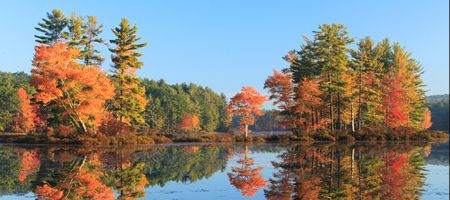New England is gradually losing its famous fall colors, says the National Science Foundation.

The annual spectacle is a comparatively recent one, and may not last forever, research at the Harvard Forest Long-Term Ecological Research (LTER) site in Massachusetts shows.
“The brilliant fall foliage so emblematic of New England forests was not always so, as the history of Harvard Forest shows,” says Saran Twombly, NSF LTER program director.
At the start of the twentieth century, much of the New England landscape south of Maine, now famed for its brilliant maples, was covered by white pine forests. But as these were harvested, they were succeeded by broadleafed trees such as maples, oaks, American chestnuts and birches, with the beautiful colors we see today.
Since then, though, there’s already been one casualty: the American chestnut, with mature trees killed by an introduced fungal disease called Chestnut Blight.
“Our forests would have produced more yellows and fewer reds with chestnuts in the mix,” says NSF ecologist David Foster.
And the sugar maple, with striking red fall foliage, may also disappear from Massachusetts in time.
The trees were planted along roadsides during the 18th and 19th as a source of sap for maple sugar. But they’re now near the southern end of their range in Massachusetts, and are likely to move north over the next century, thanks to increasing temperatures.
“Over time, the autumn colors of our forests may fade as conditions become less favorable for northern trees such as sugar maples,” says Foster.
And even those trees that are left behind, such as ashes and dogwoods, will have to deal with diseases that are already spreading through the forest – and that may be made more virulent by warmer temperatures.
And a lack of rainfall in summer – such as this year’s drought – means that trees may lose their leaves early, start to turn color earlier than usual or simplylook dull and washed out.
“The current, rapid changes linked with climate are unpredictable, threatening both the forests and our deep appreciation of them,” says Twombly.






